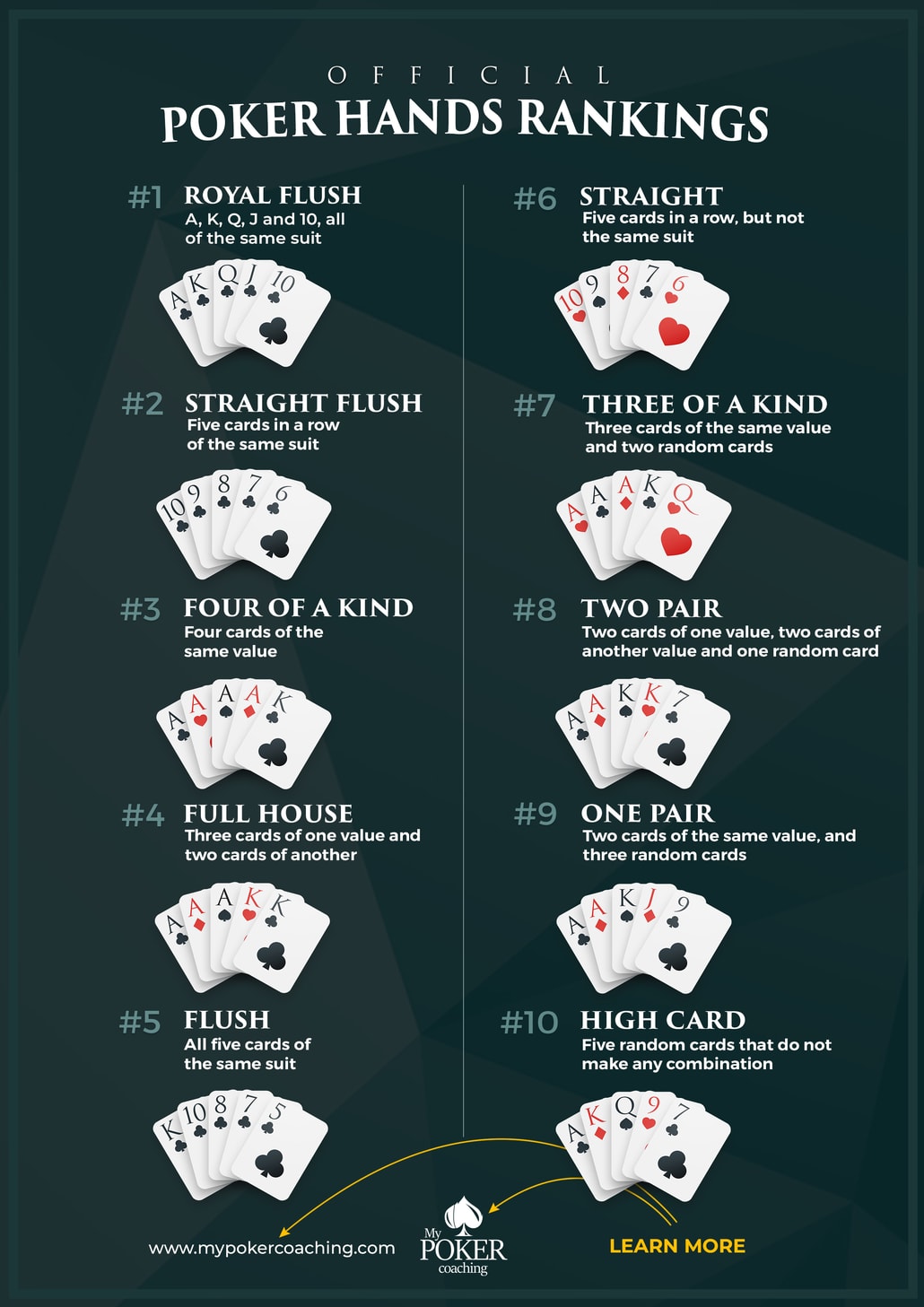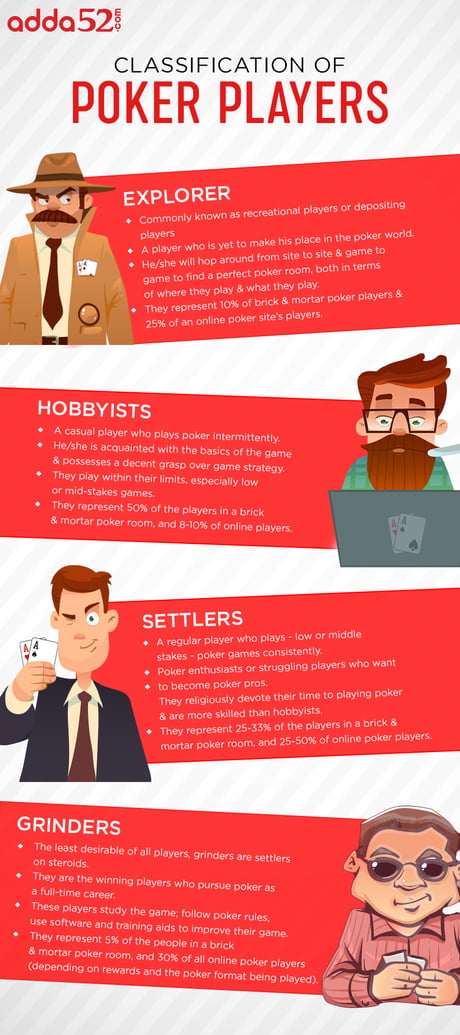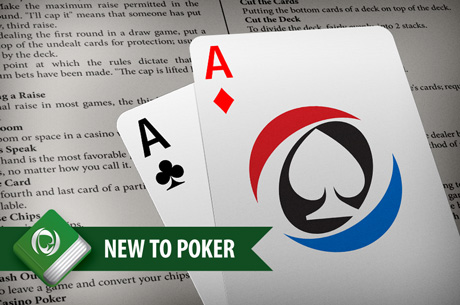Types Of Poker Players
Becoming a successful and winning poker player requires a specific skill set. Anyone who dreams for a career in poker must be disciplined, to have analytical mind, to be patient, to learn from mistakes and many more. However, there is one quality that not many people think about- observation.
Table of Contents
Seriously, has anybody gotten a royal flush ever?Bloopers: and Written by:Lingyi Xiong @BlingyiJason Hau. The different types of live poker players include wild/aggressive/loose/calling stations, the super tight player, and the conservative (generally good) player. Needless to say, there are virtually infinite types. Aggressive players on the other hand, tend to play without being scared of the end result. They prefer raising that just calling and are not afraid from investing chips in the pot. Now, once you are aware of what the different terms means we may go back to four main poker player types. The 4 Main Types of Poker Players. Played in the World Series of Poker, Texas Hold ‘Em is easily the most popular. TAG stands for “tight aggressive”. It’s the poker style of choice for the majority of winning.
Let’s say you go to a new school and you don’t know anybody in the beginning. Then after some time you will start getting to know people. Some will be polite, others will be naughty. Some will be introverts, others will be extroverts. You will meet up shy and some overconfident schoolmates. The list can go on and on.
It’s similar with poker- there are different playing tendencies whether it is an online table or a live poker event. Of course, playing with real people will pump more adrenaline into your blood. It will also give you more clues about the player, if you know what to look for.
On the other hand, playing online poker will limit your choice, but still you can draw crucial conclusions about other players and their habits.
First things first, let me start by introducing the main factors that determine the different types of poker players. There are two main categories to watch for. Players are often described by tight vs. loose and passive vs. aggressive. These can be combined and from there we can sum up four main poker player types:
- Loose-Passive
- Tight-Passive
- Loose Aggressive
- Tight Aggressive
Before going over these 4 different styles, let’s first dig in in the terms that stay beyond them.
Tight vs. Loose
The main difference between these two terms is the starting hand selection. While tight opponents limit the hands they play, loose players are not afraid from seeing flops and will get involved with wide variety of hands. To learn more about the preflop poker range construction you can check out this great resource on building 6 max opening ranges.
Take into account that being tight or loose does not describe how you will play those hands. It just describes the quantity of hands the player likes to commit chips with.
For example, while a tight player will most likely fold a hand like J9s from middle position, a loose opponent will gladly either limp/call or raise with it.
When it comes to how you will play those hands either preflop or postflop then we speak about passive and aggressive players.
Passive vs. Aggressive
When categorizing an opponent as either passive or aggressive we take into consideration their risk tolerance. Passive players from one hand stay away from confrontations and prefer limping than raising. Aggressive players on the other hand, tend to play without being scared of the end result. They prefer raising that just calling and are not afraid from investing chips in the pot.
Now, once you are aware of what the different terms means we may go back to four main poker player types.
The 4 Main Types of Poker Players
1. Loose-Passive
Тhe loose-passive players are known for limping a lot. They enjoy seeing flops, but prefer a rather conservative approach. These opponents will just call raises instead of raising themselves. This applies both for pre and postflop play. They will seldom show any aggressive actions and that’s why loose passive players are also known as calling stations. The right approach against them is to play your strong hands and to minimize any bluffing attempts.
2. Tight-Passive
This playing style is characterized by a conservative approach to the game. A typical tight-passive player will rarely involve in any hands and when he does, will do it by just calling.
These opponents are often described as “rocks” and “nits”. Good players, who observe what is happening on the table carefully, will know that when facing tight passive players they must have premium holdings. They often play with the fear of losing and will rarely take any risks. When playing in tournaments and SNGs they will often blind out while waiting to be dealt a premium hand. Against such players you can opt for blind stealing with a wider range than against loose players. The “nits” will fold their blinds far too often.
3. Tight-Aggressive
The tight aggressive style or also popular as TAG is considered to be one of the most effective and winning playing styles. It’s a powerful weapon in the arsenal of most professional poker players. TAGs do not involve in many pots preflop, but when they do- they either raise or re-raise. You will seldom witness a tight aggressive player who just calls preflop. It’s similar postflop- they will far more often raise and reraise. These players are patient and will pick up their spots carefully. They are also known as “sharks” as it is difficult to play against them.
However, there are still some strategies to help you play successfully against tight-aggressive opponents.
One of the recommended ways to understand and exploit TAGs is to attack them whenever they show some weaknesses. They will most often play their made hands aggressively, so whenever you notice them check- go for a raise! Of course, every now and then they may set up some traps, but in the long run, this would show profit.
4. Loose-Aggressive
This playing style is known also as LAG. The players who incorporate it in their arsenal like to raise and re-raise a lot of holdings and often bet on the different streets postflop (flop, turn and river).
They play such a wide range of hands that it is tough to guess what they are holding. It may vary from the absolute nutz to a pure bluff.
Along with the TAG style, LAG can be also very profitable, if used correctly. There is a great number of players who use it to perfection nowadays. Opponents that tend to play loose-aggressively will bluff a lot, so you don’t always need a premium hand to stay in the hand. For example, often even a 2nd pair will be good against their range.
Once, we went through the different categories it is crucial to mention that nobody fits on 100% in a specific category. Poker is such a dynamic game, so a TAG player may turn into a LAG, if he becomes bored, or if he decides to try another strategy and so on.
Take football/soccer for example. Depending on the situation one team may play defensively, but they may be great on counter attack as well or switch to an attacking strategy the second half. The same way some players will intentionally try to switch between different playing styles to perplex their opponents.
However, when playing low stakes chances are your opponents will stick to a higher extent to one of the already mentioned categories.
The key is observation– don’t stop paying attention to your opponents. No matter whether you play live or online, take notes of the tendencies of the players around you.
The best strategy?
Being aggressive is a key for success in poker, as long as the aggression is selective. It’s hard to tell which style will bring you most chips. It all depends on the limits you play, on your opponents, on your ambitions and so on.
Some professional poker players have huge success sticking only to the TAG style. On the other hand, there are top poker players who benefit from LAG play. Take into account that the best players constantly adjust their style to the players at the table and the specifics of the game.
So, try for yourself the different styles and see which one will suit your personality best and help you build your poker bankroll.
Poker is not just a card game, but a game of people played with cards. As you progress through the stages towards poker expertise, you will experience moments when you realize how powerful this statement is. In this lesson we’ll be looking at some of the basic poker playing styles that exist and how to spot them. Whether you’re playing online or playing live, when you observe the types of decisions your opponents make you can really pick up on their tendencies, psychologically and emotionally – that can help you determine how best to play against them.

Poker is a game of observation. Therefore the first step to defining a player’s playing style is to observe their general tendencies. This factor is the central core of poker success. Learning your opponents’ proclivities is a must if you intend to become a winning player. Every action an opponent takes means something. Why from that position did player x raise or just call? It cannot be stressed enough to pay attention, especially when not in a hand (which should be the majority of the time) to learn how your opponents think and act.
Defining Poker Playing Styles
Each poker player can be broken down into two primary factors which will broadly define their playing style. They are as follows: tight vs. loose and passive vs. aggressive.
Tight vs. Loose
This first primary factor is shown in a player’s starting hand selection
- Tight poker players usually play a small number of only the best hands.
- Loose poker players will often play a wide variety of hands.
Being tight or loose doesn’t necessarily refer to how somebody plays their hand, but merely the selection of hands that they play. They’re either going to play a tight range of hands or a loose range of hands. How they play those hands – whether it is passive or aggressive – is going to dictate how you play against them.
Passive vs. Aggressive
A players passiveness or aggressiveness is displayed in their risk tolerance.

- Passive poker players tend to avoid confrontation and play with a fear of losing.
- Aggressive poker players raise more than call and are not afraid to put chips at risk.
By observing your opponents you’ll be able to categorize them based on what you see. Each poker player you encounter will have some degree in which these factors make up their personality but you have to start somewhere. The first step is to determine whether they are tight or loose. If an opponent folds most of their hands then mark them as tight. If they tend to play a lot of hands, mark them as loose. The next factor to determine is whether they are passive or aggressive. Do they call and check more often than they raise and bet? If so, mark them down as passive. If they bet and raise a lot you can mark them down as aggressive.
The Four Basic Poker Playing Styles
By assessing these factors you will typically see four general playing style combinations:

- Tight Passive
- Loose Passive
- Tight Aggressive (TAG)
- Loose Aggressive (LAG)
Knowing these broad characteristics will help you to figure out what a player has based on his betting action in a particular hand. If a loose-aggressive player is betting and raising you are less likely to credit him with a strong hand than if a tight-passive player raises or re-raises, since it’s something they don’t usually do.
Let’s examine these four basic playing styles in more detail:
The Tight-Passive
A typical tight-passive player generally doesn’t play many pots and will often just call pre-flop when they find a hand they like. They will play so tight that when they do play, everyone else folds. So, when they have a good hand they can’t make any money. This type of player is sometimes labelled as a ‘rock’ or a ‘nit’ and the general style of play can also be referred to as ‘weak-passive’. They are easy to bluff and will frequently fold to scary board cards, such as an Ace. The really timid players can also be paralyzed with fear and won’t take shots. This is because they tend to play with a fear of losing. Observant players who have identified a weak, predictable player will always be on the lookout for situations that can be exploited simply because the tight-passive player folds too frequently to aggression.
The Loose Passive
Loose-passive players like to limp into lots of pots. They will call raises “just to see a flop” and will remain in the hand whenever they hit any of it, however marginal. They seldom take chances or become aggressive in their plays and they tend to be “calling stations” when they do. Their whole approach to playing poker is to watch and let others do the risking. Many beginners or even players who’ve played for a long time can fall into the trap of just calling, calling and calling. This is especially true in low buy-in games. They are very obvious to spot and are easy targets. Unlike the tight-passive players, you’re not going to be able to bluff them – you never want to bluff a calling station! But when you do pick up a hand that is fairly strong, you should bet for value and milk as much out of them as you possibly can.
The Tight Aggressive (TAG)
The tight-aggressive player generally doesn’t play many pots. They are selective and generally only play the best starting hands. Unlike the tight-passive players, a tight-aggressive player will play their cards strongly. They are patient and wait for the best opportunities to strike but they are not afraid of betting. The best tight-aggressive players are often labelled as ‘sharks’ because a tight-aggressive style is frequently effective, regardless of the game variation or betting structure. Most observant opponents will avoid clashing with a tight-aggressive player since they’ll assume that they have the best hand and will fold under the pressure.
The Loose Aggressive (LAG)
The loose-aggressive player tends to raise or re-raise a wide variety of hands pre-flop and will often bet on most flops. They can be extremely difficult to read because they play such a wide range of hands. In no-limit hold’em there are some very skilled players who employ a loose-aggressive style of play to great effect. They use their chips as weapons and are constantly applying pressure on their opponents. They will bluff a high percentage of the time and are hard to play against. However, at the extreme end of the loose-aggressive scale is the ‘maniac’ who seemingly raises without rhyme or reason. The maniac’s tendency to overplay his hands means you will almost surely show a profit in the long run against this type of player.
Tricky or Straightforward?
Be aware that nobody fits into very neat or specific groups. Once you’ve put players into an initial category you’re ready for the next step – which is to determine whether or not they are tricky. This is not always easy because poker players tend to fall on a continuum that ranges between extremely tricky and completely straightforward. However, it’s an important step because once you put them somewhere on the scale you can begin to intepret their actions with greater accuracy. For example, let’s suppose a tight-aggressive player raises pre-flop from early position. If he is a straightforward tight-aggressive then you can credit him with a strong hand, such as a premium pair. If you’ve determined that he’s a very tricky player then he might also be mixing it up by raising with two big cards or a suited Ace.
The key to all of this is observation. You really need to observe the players at your table and pick up on their tendencies and understand what type of plays and decisions they make based on their personality types. If you can, start to classify them into some of the groups we’ve discussed. It then makes your decisions a lot easier and more profitable.
The Importance of Aggression
Remember that poker is a game of aggression and this is especially true of hold’em. If you don’t want to be aggressive, then you shouldn’t play — or at least you shouldn’t expect to win. Poker is all about conflict and it’s not a game for the weak. This is why an aggressive style of play is critical to success. This is a central truth of the game that we all deal with every time we sit down to play. We’re trying to beat the other player and take their money. As the late great Jack Straus once said “I’d even bust my own grandmother if she played poker with me.”
Personality Types Of Poker Players
There are obviously times when it’s good to be deceptive and just call pre-flop with a premium hand or check-call a strong hand after the flop. Even aggressive players do this on occasion, but the big difference is they’re mixing up their game – unlike the tight-passive player who only calls when they should probably raise, due to a fear of losing. As the old poker saying goes, “Scared money never wins“.
The biggest downside to a passive style of play is that it only offers one way to win the pot – when you have the best hand. An aggressive style of play gives you two ways to win – when you have the best hand and when you force your opponent to fold the best hand, thereby abdicating the pot to you. For example, if you were aggressive pre-flop, depending on what cards are on the flop, you can continue your aggression by betting and often winning the hand even if you miss completely.

Which is the Best Playing Style?
Clubwpt Sign In
We’ve already discussed the importance of aggression and why it’s almost always best to be aggressive. A good solid strategy of tight and aggressive play is generally rewarded with a profit. There are some experienced players who have great success by adopting a loose-aggressive style of poker. However, for the majority of players a tight-aggressive approach is usually the most profitable. This style of play is also undoubtably the best way for beginners to start out playing poker since it teaches good habits such as patience and discipline. The tight-aggressive approach also works well as a “default position” and players often build a strong skills base by starting out with such a playing style.
Ultimately though, you should choose a style of play that is the most profitable for you and that suits your personality. In fact, your style of play at the poker table is often shaped by your personality away from the table. Some people can play very differently to their actual personality, but most will revert to type. For example, there are some players who we could label as ‘loose-aggressive/passives’ – these players will raise a lot of hands pre-flop but will often give up on the flop or turn. Typically these are former tight-aggressives or tight-passives trying to experiment with looser play but are not comfortable committing to their aggression – because it’s against their nature. So the best advice we can give is to find what works for you by playing poker and gaining experience on the felt.
It’s also important to point out that the best poker players adjust their style to the players at the table and the conditions of the game. It’s often said that if you’re playing on a table full of tight players then you should loosen up, whereas if you’re playing on a table full of aggressive players then playing a tight game and catching them in the act is an effective strategy. Always be observant of the players at your table and the conditions and adapt your style of play when necessary. It’s what good poker players do.
Related Lessons
By Donovan Panone
Famous Poker Players
Donovan started playing poker in 2004 and is an experienced tournament and cash game player who has a passion for teaching and helping others improve their game.



